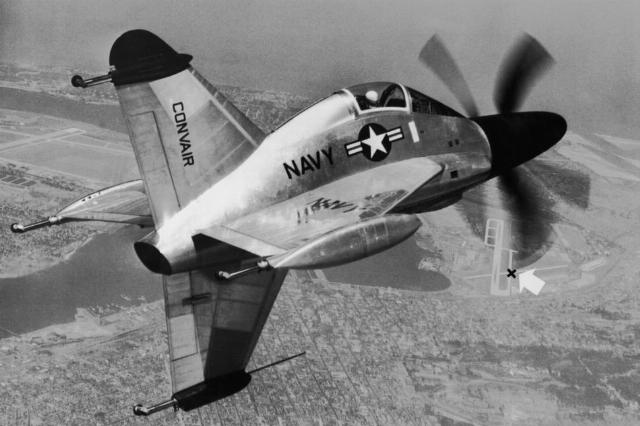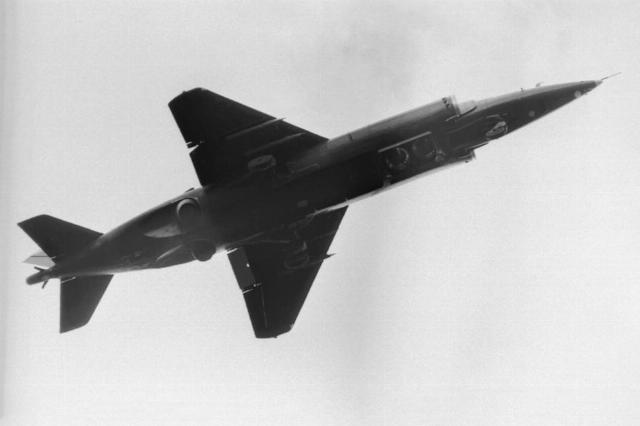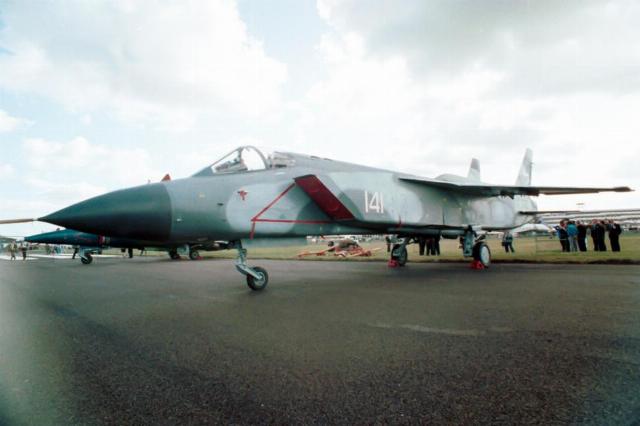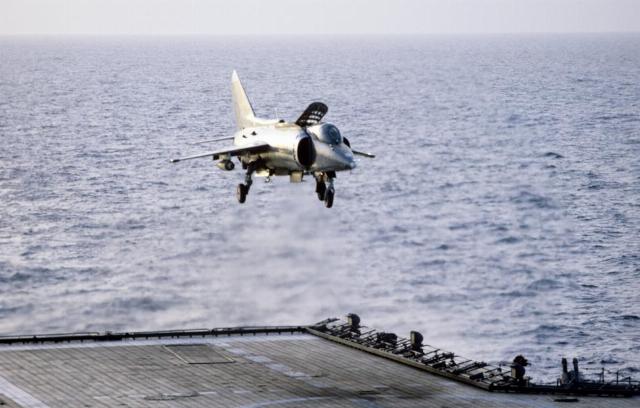Take off like a helicopter, fly like an airplane
The aircraft, which combines the speed of an aircraft and the ability to use a limited area of an airfield or the deck of an aircraft carrier for takeoff and landing, has been developed by the leading aviation powers since the second half of the last century. If earlier planes could take off and land from unpaved sites, then as aviation developed, it required longer, smoother and more durable runways. Their concrete could have been damaged by an enemy strike.

Convair XFY-1 aircraft, 1954
Image source: © Underwood Archives/ Getty Images
After World War II, in the United States, in the interests of the Navy, they experimented with turboprop and jet VTOL engines - the engines already made it possible to create thrust sufficient for the vertical launch of such aircraft. In April 1954, the Convair XFY-1, a single—seat tailless aircraft with two coaxial propellers (rotating in opposite directions), took off. During takeoff and landing, its fuselage was positioned vertically, and the aircraft rested on wheels at the ends of the wing and tail — figuratively speaking, it stood on the tail. The device made several dozen flights, but did not go into series. The same fate befell the Ryan X-13 Vertijet jet, which was developed by order of the US Air Force. To reduce the weight of the structure, the device lacked a landing gear, so it could take off and land only with the help of a special platform, clinging to it with a hook on the nose. Take-off and landing with the vertical position of the fuselage of such vehicles turned into difficult and dangerous activities.
Riding on a turbine
In the 1950s, to study the problems associated with the creation of VTOL, Soviet designers developed an experimental aircraft "Turbolet". According to open sources, its flight tests began in 1956, piloted by an unusual device test pilot Yuri Garnaev (later he also tested the VTOL Yak-36). The "Turbolet" had a mass of 2.3 tons, thrust was created by a vertically mounted turbojet engine, and the fuel reserve was enough for 10 minutes of flight. When taking off and landing at low speed, traditional aerodynamic rudders are ineffective, so the device was equipped with gas-jet rudders - they created a small thrust, the vector of which could be controlled along different axes. In 1958, the Turbolet made a spectacular demonstration flight at the aviation festival in Tushino, hovering in the air and making turns. The results obtained during the tests were applied in domestic vertical takeoff and landing aircraft. The developments on the "Turbolift" were useful even in the Soviet space program to create landers for the Moon and planets devoid of atmosphere.
The development of jet aircraft taking off with a horizontal fuselage position began in the mid-1950s. In 1960, the first flight was made by the British experimental Hawker P.1127 aircraft, a prototype of the Harrier VTOL family. In 1964, the Yak-36, a Soviet light attack aircraft for vertical takeoff and landing of the Yakovlev Design Bureau, took to the sky. The Yak-36 had two engines that, with the help of deflected nozzles, allowed it to take off vertically, an automatic control system in "vertical" mode, as well as a forced ejection system. The plane made a splash at the Domodedovo Aviation festival in 1976, taking off and landing vertically.
Yak-38: the world's first marine VTOL
The accumulated experience allowed Yakovlev to develop the Yak-36M, the first domestic VTOL aircraft to be mass—produced. The aircraft went into production under the name Yak-38.
"The Yak-38 single-seat naval attack aircraft became the first naval combat aircraft in our country and the first ship-based VTOL in the world, several years ahead of the British Sea Harrier — the deck version of the Harrier," the press service of Yakovlev PJSC reminded TASS. The Yak-38 has been in service since 1977, and the British aircraft since 1979.
For vertical flight modes, the aircraft was equipped with two lifting jet engines located behind the cabin. At the same time, the main engine had rotary nozzles that deflected its jet downwards.

VTOL Yak-38, 1990
Image source: © Gennady Hamelyanin/ TASS
PJSC Yakovlev noted that during the construction of the Yak-38, a complex problem of controlling the thrust of engines with different dynamic characteristics from a single gas control knob was solved.
"One of the most important problems in the creation of the aircraft was the rescue of the crew in emergency situations in vertical takeoff and landing modes," the company said. — The research carried out by the Design Bureau and the Gromov Institute revealed the need to create an integrated system of automatic forced ejection through the glazing of the cabin lamp. At that time, this complex emergency escape system had no analogues in world practice, and operational experience showed its high reliability."
"Vertical" in battle
The British VTOL Harrier and the decked Sea Harrier were used during the armed conflict between Argentina and Great Britain in the Falkland Islands in 1982. The aircraft used guided and unguided missile weapons, hitting various targets, and also conducted reconnaissance. Four of the fourteen aircraft in use were lost during the campaign.
According to open sources, several Yak-38s were tested during the fighting in Afghanistan in 1979-1989: they flew combat missions as attack aircraft. At the same time, not vertical, but a shortened takeoff using lifting engines was used - so the aircraft could carry the maximum combat load.
In 1972, the Yak-38 landed on the aircraft carrier Moskva, the first time a Soviet aircraft landed on the deck of a warship. The creation of a two-seat training variant of the Yak—38U machine contributed to the training of combat pilots for the difficult-to-pilot "vertical". An improved version also appeared — the Yak-38M was equipped with more powerful engines and a durable chassis.
Yak-141: the world's first supersonic VTOL
"In 1974, work began on the creation of the Yak-141, an outstanding achievement of the Soviet aircraft industry,— Yakovlev told TASS. "This aircraft became the world's first supersonic VTOL aircraft, 20 years ahead of a similar US development."
As in the case of the Yak-38, the designers successfully solved the problem of controlling the aircraft's power plant, consisting of engines of various types. The highly reliable electronic system was combined with an automatic flight control system. "This system has fundamentally simplified the process of piloting an aircraft in vertical takeoff, vertical landing and short takeoff modes, ensuring the pilot the unity of the Yak-141 piloting technique in all modes," Yakovlev PJSC reported.

Supersonic VTOL Yak-141, 1994
Image source: © Vladimir Yatsina/ tass
On the Yak-141, which made its first flight on March 9, 1987, 12 world records were set. However, difficulties with financing such defense programs in the 1990s prevented the start of serial construction of a unique aircraft.
Was it stolen or not?
Interestingly, the design of the Yak-141 rotary nozzle is similar to the nozzle of the American fifth-generation fighter F-35B (VTOL variant). This gave rise to the opinion expressed in open sources that engineers from the United States copied the Soviet design. PJSC Yakovlev denied such rumors.
"In 1992, the VTOL Yak-141 was demonstrated at one of the world's largest air shows, Farnborough," the company told TASS. - The plane became an international sensation, and the delegation of the US naval aviation also got acquainted with it at that exhibition. At that moment, the Pentagon announced a tender for the development of a supersonic vertical takeoff and landing aircraft for the Navy, one of the participants of which was Lockheed Martin. Representatives of this company actually came to Moscow in the same 1992 to discuss the possibility of concluding a contract with the Yakovlev Design Bureau, but the contract was not concluded and, accordingly, no technical documentation was transferred to the American manufacturer - this is speculation."
Yakovlev added that the design schemes of the Yak-141 and F-35B are radically different: two separate jet engines are responsible for the vertical modes of the domestic machine, while the American one has a fan that takes power from a single engine.
The future of Russian "verticals"
In 2017, Yuri Borisov, who served as Deputy Minister of Defense of the Russian Federation and oversaw the rearmament of the Russian Army, said that the Ministry of Defense of the Russian Federation was discussing the creation of a new vertical takeoff aircraft for a promising aircraft carrier.
"This is the development of the Yakovskaya line, which has been discontinued. There are such plans, we are discussing them, including, perhaps, these areas will be implemented for a promising aircraft for aircraft—carrying cruisers," he added.
In 2018, Borisov said that on behalf of Russian President Vladimir Putin, the Russian military department is working on the concept of a completely new vertical takeoff aircraft. At the same time, the former deputy prime minister stressed that we are talking about creating a new car, and not about developing on the basis of an existing one.
Electric motors to help
Siberian Scientific Research Institute of Aviation named after S.A. Chaplygina (SibNIA), on the instructions of the Foundation for Advanced Research (FPI), has been developing short-takeoff aircraft since 2019. The project is called "Development and flight tests of demonstrators of a transport unmanned aerial vehicle for ultrashort takeoff and landing with a hybrid power plant and active blowing of bearing surfaces" and has the code "Partizan". The technology demonstrator, a flying laboratory based on the TVS-2MS aircraft (a deep modernization of the famous An-2 biplane), performed demonstration flights at the MAKS-2021 air show. Ultrashort takeoff and landing are provided by a distributed propeller-driven group - eight electric motors with folding screws on the leading edge of the wing. By blowing on the wing, they create lift, which allows the use of a small area as an airfield.
SibNIA plans to certify the device, created on the basis of works on the topic of "Partisan", as a civilian passenger aircraft. According to the director of the institute, Vladimir Barsuk, the Partizan is the only aircraft in the world whose take-off and landing characteristics allow it to take off from a 50 by 50 meter site.
"The Yakovlev Experimental Design Bureau began working on the subject of vertical takeoff and landing aircraft back in the late 1950s," the Yakovlev PJSC press service told TASS. "As history shows, the Yakovlev school of VTOL corresponded to the level of the world's leading manufacturers of aviation equipment, and in some ways surpassed them."
"The results of the successful solution of a number of difficult tasks in the creation of the Yak-38, Yak-141 and a number of other projects that did not reach the creation of prototypes are certainly the scientific and technical foundation of the Yakovlev school of VTOL," the company added. "Its connection with new aviation technologies allows us to quickly return to the creation of vertical takeoff and landing aircraft, if the Russian Ministry of Defense issues Yakovlev an appropriate task."
Victor Bodrov

